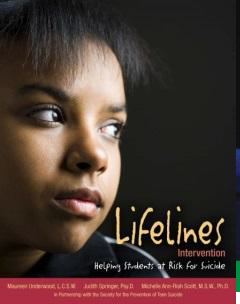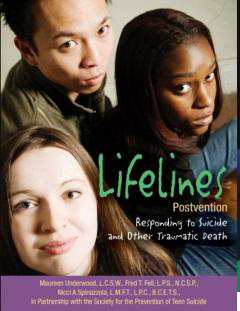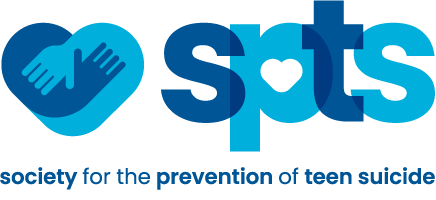SPTS expert program staff are available to meet your educational and professional development needs with a comprehensive catalog of dynamic workshops and training programs for schools, community groups, professional conferences and parents. Browse our catalog or consult with our office staff for the presentation that best fits your suicide prevention needs.
The Lifelines Trilogy: Prevention, Intervention, & Postvention
School communities who have experienced a death by suicide no longer need to be convinced of the reality of teen suicide: national data tell us that at-risk students are present in every school, at every grade level. Yet, how can schools implement procedures for identifying these at-risk students and addressing their needs – all while remaining focused on their primary functions of educating all students in a safe and healthy environment for learning? The Lifelines Trilogy™ makes school-based suicide prevention possible and practical.
Here’s what you’ll find in each component of the Lifelines Trilogy™:

Lifelines Prevention sets the foundation for a school’s competence in youth prevention by providing:
Guidelines for administrative policies and protocols that reflect confidentiality and liability
- A manualized awareness presentation for faculty and staff
- A video presentation for parents
- A four-session Evidence-Based curriculum for middle & high school students

Lifelines Intervention is the indispensable guide for identifying and responding to students who may be at suicide risk. Designed for school support and resource staff from elementary through high school, it includes:
- Practical tools for talking about suicide in a conversational manner that is developmentally appropriate – the “Tell Me More” model
- Training videos that demonstrate techniques for engaging challenging students and parents in the intervention and referral process
- Detailed information about potentially higher risk students including those who are bullied, identity as LGBTQ, are gifted, or are returning to school after a suicide-related absence

Although Lifelines Postvention was originally conceived as a tool to guide school response to a death by suicide, it has been adapted to reflect responses to all types of traumatic loss events. It outlines:
- A proactive and detailed response plan that can be tailored to meet the individual needs of a school or the circumstances of a loss
- Resources for identifying and training members of a crisis team
- Over 250 pages of resource templates
While Lifeline manuals offer the tools, templates and training curriculum for schools to implement comprehensive school-based suicide prevention, full day workshops are available in each of the components and can be provided by our skilled and knowledgeable trainers. These engaging workshops quickly enrich the competence and confidence of school staff and administration to address this important school health and safety issue.
Making Educators Partners in Youth Suicide Prevention: In-Person Training
SPTS Presenters can provide an in-person version of our Best Practices, online training. This training addresses the critical but limited responsibilities of educators in the process of identification and referral of potentially suicidal youth. It focuses on the practical realities and challenges inherent in the school setting through a variety of training formats that include lecture, question and answer with content experts, interactive exercises, and role plays. In addition to its other content, the program highlights four categories of youth who may be at elevated risk for suicide: youth involved in bullying, LGBTQ youth, gifted youth, and students being reintegrated back into school after a suicide attempt. The training includes optional content that addresses suicide in elementary and middle schools. There is also an additional module that includes the stories of individual survivors of suicide loss as well as a high school that experienced an episode of contagion. The focus in telling these stories is to highlight the importance of emphasizing resilience and protective factors after a loss event.
The program is adapted from the educator component of LIFELINES: A School-based Program for Suicide Prevention initially developed in 1989 by John Kalafat and Maureen Underwood. It incorporates material from the previous Making Educators Partners in Youth Suicide Prevention training as well as current data about risk, warning signs, and populations at higher risk. The segment on LGBTQ youth was developed in partnership with The Trevor Project and the section on bullying was created in conjunction with the Olweus Bulling Prevention Program. Content was also developed with input from survivors of suicide loss and those with lived experience.
Training of Trainers: Making Educators Partners in Youth Suicide Prevention
This Training of Trainers offering includes 90 minutes of instruction, trainer manual, flash drive with video clips and other trainer materials, and access to a learning collaborative for ongoing support. This workshop prepares participants to provide Making Educators Partners in Youth Suicide Prevention (MEP), a National best practice training. Trainer candidates must complete the two hour online Act on Facts: Making Educators Partners in Youth Suicide Prevention at www.sptsuniversity.org prior to participating in the Training of Trainers. Up to 30 trainer candidates may participate.
MEP is designed to meet the general awareness and knowledge needs of school faculty and staff and its content reflects current knowledge in the field of youth suicide prevention from the perspective of school personnel.
MEP Program Objectives include:
- Increase awareness and understanding of youth suicide
- Increase recognition of warning signs
- Improved confidence to provide an effective initial response and refer to school resource personnel.
MEP Intended Audience:
Making Educators Partners in Suicide Prevention is designed to meet the general youth suicide awareness needs of all faculty and staff in schools. There is no limit to the size of the audience. Trainers can also request a version of the training designed for use outside of school for family, child and youth services providers. If the school has had a recent suicide death, there are adaptations to fit the “survivor school” experience. Additional slides (that emphasize healing and identifying other at-risk youth) and consultation will be provided.
MEP Intended Length:
The training is designed for two hours. The content can be modified to accommodate a 90 minute, 1 hour or 45 minute presentation.
Making Youth Agencies Partners in Youth Suicide Prevention
Similar to Making Educators Partners in Youth Suicide Prevention, this program achieves three essential goals which further the mission of SPTS: increase awareness of teen suicide; outline the agency role in prevention; and review strategies for dealing with at-risk youth. SPTS can work with your organization to identify your agencies policies and procedures regarding youth in crisis. Making Youth Agencies Partners trains your organization’s staff or volunteers on the warning signs and risk factors of suicide, how to identify and talk to at-risk youth, and teaches them how to connect at-risk youth with the appropriate resources.
Raising Resilient Teens Presentations for Parents
SPTS is happy to work with your school administration to facilitate a presentation for parents. We can customize the format and length of time to best fit your audience. Our “Raising Resilient Teens” presentation educates parents on the warning signs of suicide, dispels myths, and encourages parents to speak to their children about suicide prevention. This presentation is from the Evidence-based Lifelines: Suicide Prevention program. SPTS can also work to organize a panel of local experts to help answer some of the problems plaguing today’s youth. We also can provide a presentation on the warning signs of suicide and local resources to your parents at a community presentation, PTA/PTO meeting or Back to School Night.
The Role of the Trusted Adult
This presentation educates those viewed by youth as role models (coaches, teachers, etc) on how to respond to at-risk youth. Participants learn how to engage with at-risk youth, confidentiality, warning signs and risk factors of youth suicide, protective factors and resources. This information empowers trusted adults to take action when a youth comes to them about either a friend talking about suicide or themselves.

